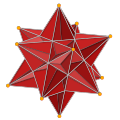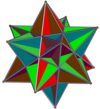Talk:Great icosahedron
| This article is rated Start-class on Wikipedia's content assessment scale. It is of interest to the following WikiProjects: | |||||||||||
| |||||||||||
Net[edit]
Why is it that the net of the great icosahedron is not given? Presumably there would be a net. --116.14.72.74 (talk) 10:09, 26 July 2009 (UTC)
- To make the great icosahedron you start with a dodecahedron with pentagonal pyramid dimples. In the dimples one needs to affix pentagrammic pyramids. See the mathworld article on the great icosahedron. Professor M. Fiendish, Esq. 14:21, 28 August 2009 (UTC)
File:Third compound stellation of icosahedron.png Nominated for Deletion[edit]

|
An image used in this article, File:Third compound stellation of icosahedron.png, has been nominated for deletion at Wikimedia Commons in the following category: Deletion requests September 2011
Don't panic; a discussion will now take place over on Commons about whether to remove the file. This gives you an opportunity to contest the deletion, although please review Commons guidelines before doing so.
This notification is provided by a Bot --CommonsNotificationBot (talk) 10:55, 3 September 2011 (UTC) |
File:Second compound stellation of icosahedron.png Nominated for Deletion[edit]

|
An image used in this article, File:Second compound stellation of icosahedron.png, has been nominated for deletion at Wikimedia Commons in the following category: Deletion requests September 2011
Don't panic; a discussion will now take place over on Commons about whether to remove the file. This gives you an opportunity to contest the deletion, although please review Commons guidelines before doing so.
This notification is provided by a Bot --CommonsNotificationBot (talk) 10:58, 3 September 2011 (UTC) |
File:First stellation of icosahedron.png Nominated for Deletion[edit]

|
An image used in this article, File:First stellation of icosahedron.png, has been nominated for deletion at Wikimedia Commons in the following category: Deletion requests September 2011
Don't panic; a discussion will now take place over on Commons about whether to remove the file. This gives you an opportunity to contest the deletion, although please review Commons guidelines before doing so.
This notification is provided by a Bot --CommonsNotificationBot (talk) 11:01, 3 September 2011 (UTC) |
Conway-style notation for star polyhedra[edit]
See: Talk:Great_dodecahedron#Conway-style_notation_for_star_polyhedra — Preceding unsigned comment added by 99.185.3.0 (talk) 18:04, 23 December 2013 (UTC)
Retrosnub tetrahedron[edit]
This name is not supported by the references given. I strongly suspect that it is WP:OR and needs to be deleted. Can anybody confirm a source for this name? — Cheers, Steelpillow (Talk) 09:24, 18 September 2014 (UTC)
- I'll ask around where the name came from. Norman Johnson named all the full symmetry constructions. Richard Klitzing has the only list I know for all of the Wythoff constructions and includes 3 names: great icosahedron, retrosnub tetrahedron, retrosnub tetratetrahedron. [1]. It is similar to great retrosnub icosidodecahedron, sr{3/2,5/3}, compared to sr{3/2,3/2}. Tom Ruen (talk) 10:58, 18 September 2014 (UTC)
I found message archives from George Olshevsky calling it a retrosnub tetrahedron as far back as 1996, and Norman Johnson also added retrosnub octahedron for its octahedral/pyritohedral construction in 2002 and 2006 messages. But I still can't say about published references. Tom Ruen (talk) 12:26, 18 September 2014 (UTC)
- 41 {3/2}|4 2| s*O = Retrosnub octahedron = great icosahedron
- 41 {2 3/2 3/2} s*TT = Retrosnub tetratetrahedron = great icosahedron
- Coxeter lists the | 2 3/2 3/2 construction in his paper, but doesn't name it, IIRC. Double sharp (talk) 23:50, 18 March 2015 (UTC)
The two images of this shape[edit]
Currently, we have:
-
Great icosahedron.png
-
Great icosahedron.svg
User:Double sharp's comment on reverting to the PNG: "that SVG which is nigh-impenetrable at small sizes and seems oddly indecisive on when shadows should exist for the edges - nah, not better"
This is applicable to both this article and {{Reg polyhedra db}}. At the size they're shown in this article:
-
Great icosahedron.png
-
Great icosahedron colored.png
-
Great icosahedron.svg
I'm not sure what's meant about it being "nigh-impenetrable". The SVG looks pretty intelligible to me. Furthermore, I can't see that "indecisive on when shadows should exist for the edges" is sufficient grounds for rejecting that image. Surely, what's most important is that it's not misleading. The PNG certainly is misleading: as a result of several face orientations having the same shade of red, together with the absence of edge lines where faces intersect, some of the hollows appear as flat faces, and therefore it shows a number of the faces as being pentagrams. In fact, all the faces are triangles.
This isn't to say the SVG can't be improved. But since the PNG is misleading, I can't see it as being better on any level. As such, I say the right course of action is:
- Produce an SVG that shows, accurately and more clearly at small sizes, what a great icosahedron looks like
- If this can't be done quickly, then use the existing SVG for the time being, as the lesser of two evils.
Comments? — Smjg (talk) 21:39, 29 May 2018 (UTC)
- @Smjg: On further examination of the SVG, I see that different parts of the same triangular face have different shades of red that cannot be explained by their orientation (because the parts oriented towards the viewer are darker instead of brighter). This is pretty much the same problem as the inconsistent shadows on some edges. So I would claim that the SVG is actually more misleading as it doesn't reflect how the great icosahedron looks from any angle, while the PNG does.
- For the Kepler-Poinsot solids, I think it would be better to forego the symmetric colouring, and instead use an arrangement of multiple colours so that neighbouring faces do not share the same colour. This should let the faces stand out more while keeping consistent lighting. Unfortunately my copy of Stella (the software that made the original PNG) died with my previous computer, but Tomruen should be able to do this (IIRC Stella has such schemes listed as icosahedral colour arrangements or something similar). In the meantime, however, the lighting concerns lead me to favour the current PNG until such a replacement is made (preferably for the other three regular stars as well). Double sharp (talk) 02:23, 30 May 2018 (UTC)
- I added a multicolored face version above, similar orientation. I also remade the original one to better show face-plane shading. Tom Ruen (talk) 10:33, 30 May 2018 (UTC)
- @Tomruen: Thanks! I think both versions (multicoloured PNG and original PNG) are good now. I prefer the multicoloured one as the lede image, but not strongly since sometimes the pure red one reflecting its symmetries makes more sense (as in the truncation sequence further down the article). Double sharp (talk) 14:11, 30 May 2018 (UTC)
- @Double sharp: @Tomruen: Thanks both. It's certainly better now. Not perfect, but better. It really ought to be an SVG, but anyhow. Can't make up my mind what I think to the coloured version.... — Smjg (talk) 14:31, 31 May 2018 (UTC)
- I'm glad to help. I agree SVG can be superior, but I did upload as a large 2000x2000 pixel image (slightly smaller cropped). Tom Ruen (talk)






